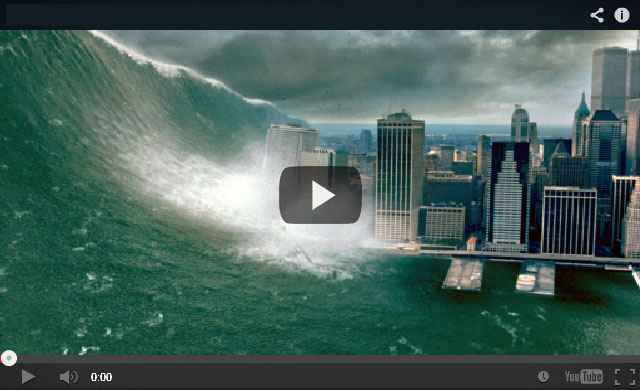To those reared on the coasts, with a traditional understanding of earthquakes as arising from titanic disagreements at the edges of tectonic plates, this all sounds quite strange. Indeed, the USGS earthquake hazard map of the United States, might also come as something of a shock. The familiar culprits are there: the entire West Coast predictably lights up as a long, narrow hazard zone—from the cascades to southern California. But in the center of the country there’s also a bewildering, giant fuchsia bullseye—smack in the middle of what should be the stable interior of North America.
VIA : usgs.gov
Earthquake Early Warning Around the World
Strong seismic shaking from an earthquake travels at about 2 miles per second, so it is possible to detect a large earthquake near its source and broadcast a warning of imminent strong shaking to more distant areas before the shaking arrives. Such systems are operational in several countries around the world, including Mexico, Japan, Turkey, Romania, China, Italy, and Taiwan. All of these systems are tailor-made for the local system of faults and thus cannot readily be adapted to California.
Examples of Early Warning Systems
- Mexico City has an EEW system that warns of strong shaking from large earthquakes that occur off of the country’s coast. The system consists of a series of sensors located along the coast that detect shaking from a large earthquake and rapidly determine the location and magnitude. Since Mexico City is located several hundred miles from the main plate boundary they can receive up to a minute or more of warning of the impending shaking. This system has been in operation since 1991.
Japan currently has the most sophisticated early warning systems in the world. The warnings were initially developed for use in slowing and stopping high-speed trains prior to strong shaking. The success of that program in addition to the devastating effects of the 1995 Kobe earthquake paved the way for building a nationwide early warning system. Japan has built a dense network of on- and off-shore seismic and geodetic instruments to rapidly detect earthquakes. They have been issuing public warnings since 2007.
Time to Detect an Event


An earthquake early warning system on the west coast of the United States could provide as much as 60 seconds advance warning prior to strong shaking arriving depending on the location of the location of the earthquake and the recipient of the warning. The time required to detect and issue a warning for an earthquake is dependent on several factors:
- Distance between the earthquake source and the closest seismic network seismometer (station). It takes a finite amount of time (2 miles per second) for seismic waves to travel from the source (e.g. the point on a fault that is breaking) to the seismic station. The first waves to arrive at a station are the lower amplitude “P waves” that travel at 3-4 miles per sec, on average. The large amplitude (more damaging) “S waves” travel at ~ 2 miles per second. Therefore, the closer a station is to the fault, the more rapidly the earthquake can be detected. Accurate detections often depend on multiple ground motion measurements from more than one station; so, increasing the density of stations near the fault can improve detection times.
- Transfer of information to the regional networks. Data from multiple stations must be collected and analyzed by the regional seismic networks, so ground motion information must be transferred from the station to the processing center. Existing networks use a variety of methods to send data back to the server to improve robustness, including radio links, phone lines, public/private internet, and satellite links. In addition, delays from packaging and sending the data from the station must be reduced in order to provide useful warning times.
Detection and characterization of an earthquake. Ground motion records received from the stations in real time are used to detect if an earthquake is occurring and rapidly determine the location and magnitude of the event. We are developing multiple algorithms to estimate the earthquake information as rapidly as possible.
In 1999, FEMA identified four hazards in the United States that, were they consummated in all their destructive wonder, would be worthy of the title “catastrophic.” They were: a major earthquake hitting Los Angeles, a major hurricane hitting Miami, a major hurricane hitting New Orleans (check), and a giant earthquake hitting the Central US.
The source of all this anxiety is the fabled New Madrid Seismic Zone. In the winter of 1811 and 1812, three earthquakes of magnitude 7, and possibly as high as 7.7, and countless punishing aftershocks thereafter, rocked the sparsely inhabited frontier of the American Midwest. The earth had slipped somewhere deep under the frontier settlement of New Madrid, Missouri, and the resulting earthquakes opened up chasms, diverted the Mississippi, threw trees to the ground and landslides into the river. It created temporary waterfalls and lasting lakes. Meanwhile, existing lakes were turned inside out, as cracks in the ground spewed volcanoes of sand and water into the air. Boatmen caught in the maelstrom said the Mississippi appeared to run backwards. The quakes woke New Yorkers, rang church bells in Charleston, South Carolina, buzzed bemused Torontonians a country away, and brought down chimneys from St. Louis to Cincinnati. Because the deep rock in the middle of the continent is older and colder than out west, strong shaking was felt over an area 10 times that of the 1906 San Francisco earthquake. An alarmed President James Madison even wrote Thomas Jefferson from DC about the tremors.
We have yet another massive wave Anomaly coming from Antarctica. I have caught several of these in the past few months, with point of origin hidden on all of them. All We know is that it must be coming from one of the dozens of Mystery Bases in this area.
According to the U.S. Geological Survey, for the seven-day period following Tuesday, the chances of a magnitude-7 or greater earthquake being triggered on the southern San Andreas fault are as high as 1 in 100 and as low as 1 in 3,000. The chances diminish over time.
Experts said it’s important to understand that the chance of the swarm triggering a big one, while small, was real.
“This is close enough to be in that worry zone,” seismologist Lucy Jones said of the location of the earthquake swarm. “It’s a part of California that the seismologists all watch.”
“When there’s significant seismicity in this area of the fault, we kind of wonder if it is somehow going to go active,” said Caltech seismologist Egill Hauksson. “So maybe one of those small earthquakes that’s happening in the neighborhood of the fault is going to trigger it, and set off the big event.”
And that could set the first domino off on the San Andreas fault, unzipping the fault from Imperial County through Los Angeles County, spreading devastating shaking waves throughout the southern half of California in a monster 7.8 earthquake.
Los Angeles could feel shaking for a minute — a lifetime compared with the seven seconds felt during the 1994 Northridge earthquake. Shaking waves reach as far as Bakersfield, Oxnard and Santa Barbara. About 1,600 fires spread across Southern California. And powerful aftershocks larger than magnitude 7 pulverize the region, sending shaking into San Diego County and into the San Gabriel Valley.
The Shakeout simulation says it’s possible that hundreds of brick and concrete buildings could fall, and even a few fairly new high-rise steel buildings. The death toll could climb to 1,800 people, and such an earthquake could cause 50,000 injuries and $200 billion in damage.
290 Earthquakes in 104 Hours: Salton Sea ‘Swarm’ Prompts (Slight) Increased Risk of Large Quake. This comes after the U.S. Geological Survey found the Salton Sea swarm may add stress to the San Andreas Fault, by the slightest amount, potentially increasing the likelihood of an earthquake of magnitude-7 between now and Oct. 4.
“Preliminary calculations indicate that, as of 10:00 am (PDT) Sept. 27, 2016, there is a 0.03%-1% chance (1 in 3000 to 1 in 100) of a magnitude 7 or greater earthquake being triggered on the Southern San Andreas fault within the next seven days through October 4, with the likelihood decreasing over time,” the USGS said. “This probability range is estimated using several models developed in California to assess foreshock/aftershock probabilities.”
An aerial view of the Salton Sea. Image via Shutterstock.
But does this mean that we’re due for The Big One this week? You don’t need to pack up your bags to move back East just yet, seismologists caution.
“The [percentage increase numbers] are so small that really, I would say there isn’t any more of a chance than normal,” Jennifer Andrews of the Caltech Seismological Laboratory told Patch on Friday. “[The swarm] very very slightly increases the risk.”
Famed Seismologist Dr. Lucy Jones added on Twitter on Friday that the “…Swarm is over” and the increased risk for a large quake was “mostly” gone.
Andrews says response from the general public to the swarm has been relatively low, as not many people reported feeling any of the quakes.
“It’s pretty much back to background levels now,” she added of seismic activity in the Brawley Seismic Zone come Friday. “Just always be prepared.”
Are you ready for end of the world and ice age.
Survival Food Prepping Ideas/ULTIMATE Top Skills 2017
Discover how to survive: Most complete survival tactics, tips, skills and ideas like how to make pemmican, snow shoes, knives, soap, beer, smoke houses, bullets, survival bread, water wheels, herbal poultices, Indian round houses, root cellars, primitive navigation, and much more at: The Lost Ways
The Lost Ways is a far-reaching book with chapters ranging from simple things like making tasty bark-bread-like people did when there was no food-to building a traditional backyard smokehouse… and many, many, many more!
Here’s just a glimpse of what you’ll find in The Lost Ways:
From Ruff Simons, an old west history expert and former deputy, you’ll learn the techniques and methods used by the wise sheriffs from the frontiers to defend an entire village despite being outnumbered and outgunned by gangs of robbers and bandits, and how you can use their wisdom to defend your home against looters when you’ll be surrounded.
Books can be your best pre-collapse investment.
The Lost Ways (Learn the long forgotten secrets that helped our forefathers survive famines,wars,economic crisis and anything else life threw at them)
Survival MD (Best Post Collapse First Aid Survival Guide Ever)
Conquering the coming collapse (Financial advice and preparedness )
Liberty Generator (Build and make your own energy source)
Backyard Liberty (Easy and cheap DIY Aquaponic system to grow your organic and living food bank)
Bullet Proof Home (A Prepper’s Guide in Safeguarding a Home )
Family Self Defense (Best Self Defense Strategies For You And Your Family)
Survive Any Crisis (Best Items To Hoard For A Long Term Crisis)
Survive The End Days (Biggest Cover Up Of Our President)
Drought USA (Discover The Amazing Device That Turns Air Into Water)




